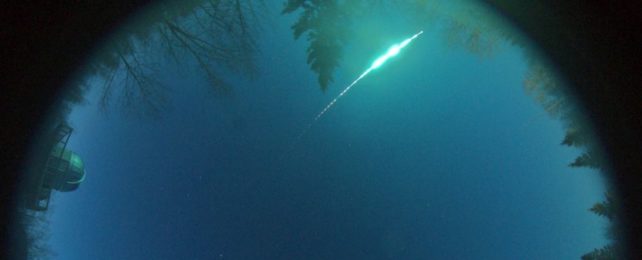Earth is under constant bombardment from space. Dust, pebbles, and chunks of rock fall into our atmosphere on a daily basis, sometimes burning up spectacularly in a blazing streak across the sky.
These bolides, or fireballs, are typically larger pieces of asteroid or comet that have broken off their parent body and wound up falling into Earth's gravity well.
But scientists have ascertained that one such fireball that exploded over Canada last year is not the usual kind of meteor. Based on its trajectory across the sky, a team has traced the object all the way through the Solar System to a starting point in the Oort Cloud – a vast sphere of icy objects far, far beyond the orbit of Pluto.
It's not extremely unusual for material from the Oort Cloud to be ejected and sent inwards towards the Sun. However, this one burned up and exploded in a manner that said it was made of rock, not the chunk of frozen ammonia, methane, and water we might expect of an Oort Cloud object.
It's a discovery that suggests our understanding of the Oort Cloud could use a little tweaking.
"This discovery supports an entirely different model of the formation of the Solar System, one which backs the idea that significant amounts of rocky material co-exist with icy objects within the Oort Cloud," says physicist Denis Vida of the University of Western Ontario in Canada.
"This result is not explained by the currently favored Solar System formation models. It's a complete game changer."
Visitors from the Oort Cloud that we've identified to date are extremely icy. They're sometimes known as long-period comets, on orbits around the Sun that take hundreds to tens of millions of years, at random inclinations, and highly elliptical.
They're thought to have been kicked out of the Oort Cloud between 2,000 and 100,000 astronomical units from the Sun by gravitational influences, and flung inwards on their looping paths.
Because a good number of these long-period comets have been identified, scientists have a decent idea of the characteristics they (and their orbits) have in common.
This brings us to 22 February 2021, when a fireball streaked across the sky some 100 kilometers (62 miles) north of Edmonton, Canada. It was observed and recorded by multiple instruments, including satellites and two Global Fireball Observatory cameras here on Earth.
For 2.4 seconds, these cameras tracked the meteor over 148.5 kilometers, giving scientists detailed data on the object's trajectory and disintegration. Fireballs are thought to heat up and explode as atmospheric gases seep into minute cracks in the rock, pressurizing it from the inside and causing it to go boom.
The object, Vida and his team found, was around 10 centimeters (4 inches) across, with a weight of around 2 kilograms (4.4 pounds). It was thought to have fallen deeper into the atmosphere than any icy object has ever been known to. In fact, its burn and disintegration were exactly consistent with a rocky fireball.
However, when the researchers used the data to calculate its inbound trajectory, the results they got were consistent not with the usual local meteor, but the orbit of a long-period comet.
"In 70 years of regular fireball observations, this is one of the most peculiar ever recorded. It validates the strategy of the Global Fireball Observatory established five years ago, which widened the 'fishing net' to 5 million square kilometers of skies, and brought together scientific experts from around the globe," says astronomer Hadrien Devillepoix of Curtin University in Australia.
"It not only allows us to find and study precious meteorites, but it is the only way to have a chance of catching these rarer events that are essential to understanding our Solar System."
From this one object, the researchers were also able to search the Meteorite Observation and Recovery Project database and published literature for possible Oort Cloud origins, and identified two other meteors: one that fell over Czechia in 1997, called the Karlštejn fireball, on an orbit similar to Halley's Comet, and 1979 meteor MORP 441, which also had a comet-like trajectory.
This suggests that, rarely, rocky meteors might be winding up on Earth after a long journey from the Oort Cloud, thought to be primordial material left over from the formation of the Solar System. Figuring out how and why the objects remained rocky, and then ended up here, is the next step.
"We want to explain how this rocky meteoroid ended up so far away because we want to understand our own origins. The better we understand the conditions in which the Solar System was formed, the better we understand what was necessary to spark life," says Vida.
"We want to paint a picture, as accurately as possible, of these early moments of the Solar System that were so critical for everything that happened after."
The research has been published in Nature Astronomy.
